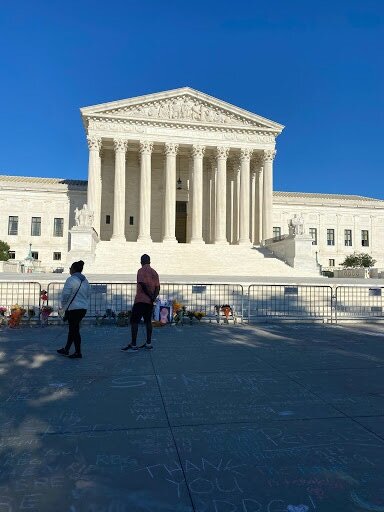How (Not) To Renew a City
December 31, 2021 | By Amelia Dilworth BR ‘23
image description: an aerial view of high-rise buildings within a lush fantasy city
The Pruitt-Igoe housing projects sink into the ground one broken window at a time, sections of buildings falling in waves like rows of wounded soldiers faltering to their knees before collapsing in the rubble. Smoke rises from the ground, the same color as the crumbling gray walls. Apartments lay in the rubble ripped open like carcasses. Half-exploded buildings kneel in the remains of their brothers, awaiting destruction.
This is St. Louis, Missouri. America is bombing its own city.
In 1972, the US Department of Housing and Urban Development decided that Pruitt-Igoe was a failure beyond redemption. During the building’s final years, the mostly vacant complex became a site for drug deals. The few remaining residents lived in fear of the violent, trash-lined hallways between their apartments and the elevators. They said the complex smelled like urine, constantly. Pruitt-Igoe was unsafe, unsanitary, undesirable; it was a place of fear.
The state and federal governments created a monster so terrible it must be destroyed.
But it wasn’t always like this.
The Pruitt-Igoe housing project was built in 1950, a time after World War II but still entrenched in racial segregation. This is the era of Urban Renewal: a desire to eradicate the crime and disease of the city, replacing it with beautiful, healthy new creation. Essentially, city planners wanted to erase the evidence of poverty in American cities.
City planners recognized the slums as “blighted” areas, homes that were not healthy and fruitful parts of the landscape. St. Louis sees the scars of poverty and looks for healing.
The state commissioned the firm Leinweber, Yamasaki, and Hellmuth to design a housing project to replace the slums: the Pruitt-Igoe. [1] The poor, mostly Black, residents of St. Louis could then leave the slums, which would be destroyed and then redeveloped into a business district.
The thirty-three eleven-story buildings stand out from the urban fabric of St. Louis; they are built on 57 acres of land cleared from the middle of ghettos and slums. Photographs show the modernist design rising above open brown ground, surrounded by a hodgepodge of tiny dark buildings on all sides. The Pruitt-Igoe is a new future, a new architecture with a radical perspective on the streets of St. Louis. It’s bright post-war modernism amidst a decaying city.
Inside, a crew of maintenance men constantly clean the Pruitt-Igoe buildings. The complexes have skip-stop elevators, which only stop at the glazed internal galleries on every third floor; the laundry and storage rooms are located on these central floors, creating “individual neighborhoods” and fostering a sense of community within the complexes. [2] Units have windows overlooking spacious courtyards; Pruitt-Igoe is almost a paradise for the families who first move in.
One tenant described the complex in its early days as being “like a hotel resort.” Another called it, “an oasis in the desert. “All this newness,” she continues, “I never thought I’d live in that kind of surrounding.” [3] In the 2011 documentary The Pruitt-Igoe Myth, individuals who lived in Pruitt-Igoe as children recall fond memories. One tenant remembers running through breezeways and stairwells, saying “it was a place where kids really had a chance to play hard.” [4] “Pruitt-Igoe was a safe place for me,” another tenant said. Growing up surrounded by neighbors, she felt that “you knew the people and you were never alone. There’s people here, there’s light here, there’s life here.” [5]
Residents felt they had escaped the disease and danger of the slums. Everything was picture-perfect. For a little while.
No one asked why the poor lived in the slums. No one asked how a neighborhood becomes “bad” or “blighted,” how it becomes unclean, unsafe. No one looked at the people experiencing poverty.
St. Louis’ city planners, and the proponents of urban renewal across the nation, failed to understand that slums are not an architectural style, but an environment created by concentrated poverty and racial oppression. Slums become ugly and unhealthy only because they bear the burdens of the ugliest and unhealthiest societal issues of this country.
From its inception, money influenced the design of the Pruitt-Igoe. Pressure to keep costs to a minimum meant all the buildings were high-rises, and the materials were the cheapest, worst quality on the market. It was designed during segregation and never successfully integrated. Pruitt-Igoe was designed to house a higher density than the slums it replaced. The galleries, intended to be places for community-building, became dangerous and dirty. Children used the elevators as bathrooms.
The Pruitt-Igoe was a new building, but constructed within the same infrastructure as the slums it replaced. It was not a new creation, only an updated facade for the city’s original sins. Maintenance would be funded by residents’ rent: but the Pruitt-Igoe wasn’t designed for a post-war St. Louis, where the population would shrink as the wealthy fled to the suburbs. The only people who lived in Pruitt-Igoe were those unable to afford anywhere else. The low-quality construction quickly failed, the tenants of Pruitt-Igoe became poorer, and as more and more residents left, these problems compounded until the complex was the site of just as much crime and violence as the slums of twenty years earlier.
The Pruitt-Igoe wasn’t a solution to the slums—in fact, it didn’t even address the real problems. The Pruitt-Igoe was built in the era of urban renewal: an impulse to replace the landscape of marginalization without addressing the impacts of marginalization on poor people of color, manifesting as a lack of jobs and inadequate resources. Those in power chased a self-serving vision of beautiful new buildings for a bustling post-war city, without understanding that poverty originates in injustice. The St. Louis housing authorities wanted to remove the ugliness of poverty from the city, but they did not plan to eradicate poverty itself. The commissioners of Pruitt-Igoe anticipated a real need for affordable, quality housing to accommodate a growing city: yet they built it over a foundation of marginalization and oppression.
In the 1970s the city determined that the cheapest response to the failing Pruitt-Igoe was demolition and ultimately exploded the entire project.
Without understanding the factors that create slum conditions, the city recreated the same slums they tried to replace, leaving a scar in the city worse than what they began with. Humanity attempts to replace brokenness with beauty, but often only leaves further brokenness.
During Urban Renewal, city planners constructed housing projects without concern for the people who would live there. They abandoned the new development without giving residents the resources to maintain it. Expecting a physical structure to resolve generational struggles minimizes and objectifies the challenges facing the urban poor.
New buildings are not new creation, they do not heal the city. Architecture bears the city’s traumas, and buildings are the body broken under the violence against its inhabitants. Cities can destroy a physical building, but the people who lived there still face the same issues that forced them to live in a dangerous neighborhood. The land reflects the lack of basic respect for other people, regardless of where they live.
A society that looks for the cheapest “solutions” to poverty and oppression devalues its residents. American cities today are dirty and diseased because they are cruel to the earth and to its people. Cities need more than housing: cities need leaders who can see the impacts of systemic racism and poverty, leaders who know and love all the people in their cities. The sustainable, healthy, beautiful city is the product of a society that recognizes the humanity of the marginalized.
Jesus exemplifies this respect for the marginalized, showing kindness to ethnic groups and social classes considered outcasts. It is in making ourselves new, in becoming more like Him, that we can heal our cities. God’s desire is for us to live in a garden, at peace with Him and each other. Someday he will restore our cities socially and physically, but until then our focus should be on the one thing we can do: allowing ourselves to be renewed, reconciled to God and thus to each other.
Today, the site of the Pruitt-Igoe has become overgrown with an urban forest, as new life blossoms from even the darkest places.
1, 2. Bristol, Katherine G. “The Pruitt-Igoe Myth.” Accessed May 18, 2021. https://rasmusbroennum.files.wordpress.com/2011/11/1991-bristol-pruitt-igoemyth.pdf.
3, 4, 5. Freidrichs, Chad, Brian Woodman, Jaime Freidrichs, Jason Henry, Benjamin Balcom, and Steve Carver. 2012. The Pruitt-Igoe myth. New York: First Run Features.







October 31, 2021 | By Shayley Martin DC ‘22
More and more nonprofits are questioning the charity model because it suggests a big power imbalance: wealthy donors versus poor recipients. Since charities rely on donors, they have to guard against valuing donors’ interests more highly than the needs of the people they want to help.
And they don’t always succeed.